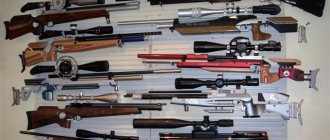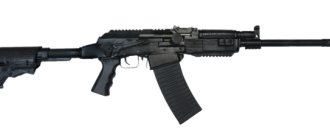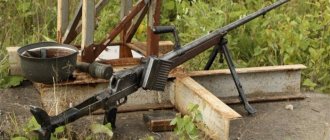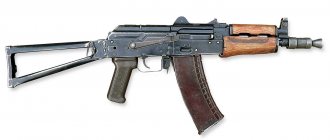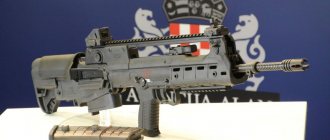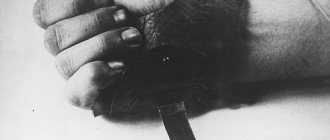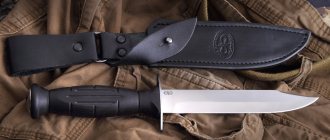History of the sword part 8.1: Two-handed sword “spadon”, “zweihander” or “biedenhander”.
So, Spadon, Zweihander, Biedenhander - “two-handed” or “two-handed” or a classic two-handed sword. Tue half XV - first floor. XVII century Area - Holy Roman Empire of the German nation, Switzerland, other countries of Western Europe (density is much lower). The largest of all known variants of bladed weapons. The only and rather dubious competitor in this regard is the Japanese two-handed saber “nodachi”.
Spadon - the rise of the Swiss battle.
The length of the blade of some specimens reaches 170 cm. The average length of the blade is approximately 130-140 cm. The average total length is 170-180 cm. A piercing weapon.
Most likely originated from the so-called. “saddle swords” of mounted men-at-arms (14th-16th centuries), which were used by the latter in foot combat. The place of invention is obviously Switzerland. Used exclusively by infantrymen - main mod. Swiss and Landsknechts. It was a weapon for the guard of banners, trabants (regular bodyguards of the command staff), and also, at the initial stage, a field weapon. The last point is not obvious, dubious and raises many tactical questions. A warrior - a “master of the great sword” - ALWAYS received double pay, regardless of his position. The spadon was an individual weapon, not a personal one, so it was worn, like a pike or a halberd, paired with a second sword (usually the so-called lansquenetta) or, later, with a sword.
The heel of the blade, both on the early samples and, especially, on the later ones, is not sharpened and was used for interception when carrying out rather complex and original fencing techniques. Later versions (approximately from the 30-40s of the 16th century) are equipped with spikes or a “crescent” set on the lower part of the heel. Apparently, their main purpose is to protect the hand when intercepting the heel. There was probably a secondary, combat purpose.
The blade usually had no fuller and was straight, but there were also wavy, “flaming” blades. In the latter case, the sword was called a flamberge.
The cross could be either ordinary - straight, or figure-eight (at an early stage). Since about the 40s. 16th century There are also more bizarre forms, equipped with side rings, etc.
The long handle was usually made of wood covered with leather and wrapped with wire. Decoration from tassels of dense threads is not uncommon, serving both for decoration and for practical purposes - to absorb blood flowing down the blade and capable of causing the handle to slip.
The percentage of two-handed swords in the army has never been high. The main bladed weapons were the pike and, to a lesser extent, the halberd. Over time, two-handed weapons became more and more decorative, and their number, like the number of halberds, decreased. Nevertheless, the fighters who owned them enjoyed significant authority until they completely abandoned this type of weapon.
The Zweihander is a two-handed sword from the Renaissance era.
Average length 1.8 m.
Average weight 3 kg.
Originating in Germany in the 14th century, the zweihander rose to prominence during the 16th century as the distinctive weapon of the German Landsknecht from the time of Maximilian I. The zweihander was supposedly used in the first Landsknecht front lines, where they were used to cut through the ranks of opposing pikemen and spearmen, whose spears presented a difficult barrier for conventional weapons, and especially cavalry.
Perhaps the most famous user of the Zweihander was Pier Gerlofs Donia, who is reputed to have wielded the Zweihander with such skill, strength, and efficiency that he was able to decapitate numerous people with a single blow. The Zweihander he owned is on display in the Frisian Museum. It has a length of 213 cm and a weight of approximately 6.6 kg.
Guards could be simple or decorative, while hilts usually ended with a heavy pommel in the shape of a heart or pear. Sometimes the unsharpened part of the blade (the heel), or fehlscharfe (German for "lost sharpness") allowed the other hand to grasp the sword below the guard, shortening the grip, resulting in the zweihander being held like a polearm. This allowed its owner to repel a cavalry attack. Zweihanders had side rings attached to the hilt, thereby increasing the guard to 35cm in width. Along the blade, approximately 10-20cm from the end of the guard, there were "parrying hooks" (parierhaken) designed as protrusions or ridges, acting as a guard for the heel of the blade, preventing other weapons from sliding down the zweihander's blade.
According to late medieval accounts, previously, most types of zweihander were used to "break through" pikemen's formations, first breaking the pikes and then hitting the pikemen themselves.
Some scholars suggest that this is a modern legend, and that the zweihander was primarily used for demonstration fencing. But at least as a legend, the concept of "zweihander" appears at least in the 17th century, if not in the late 16th century. A fanciful description of a zweihander being used against a halberd in battle lines appears in a Polish chronicle dating from 1597.
The soldiers were trained in the use of the Zweihander (the name Meister des langen Schwertes was provided by the Marx Brotherhood), receiving double pay as a regular infantryman, and were called Doppelsoldner ("double mercenaries"). These landsknechts were often used as guards for artillery batteries.
It would not be superfluous to add that the Zweihander - despite some “exoticism” - managed to outlive all other types of swords in Europe.
“Spadon” and “Zweihander” are similar, like twin brothers. Sons of one era when infantry began to dominate the battlefield.
x 1. Sword of the second half of the 16th century. Two hooks in front of the hilt are designed to “shorten” the guard at some points in the fight, slow down slashing blows and increase the power of direct blows. The wavy blade was designed to cause the most serious injuries.
2. Espadon, end of the 16th century.
3. Second half of the 15th century.
4. End of the 15th century.
5. 1500
6. Mid-16th century. This is an Italian ospadone a due tagi (two-handed slasher).
7. Mid-16th century
8. 1520 You can see the guard in the shape of the letter “S”.
9. Soldier in full armor, 1520
10. Scotsman, 16th century, with a claymore (claymore or claid-heamth). A two-handed sword was usually worn on the back.
11. Soldier "on double pay", 1580: veterans who fought in the front rank and more or less clad in cuirasses received double pay, hence their name odouble-soldeso.
Contemporaries often talked about the danger posed by the “masters of the sword,” who with one swing of their weapon put their enemies to flight. But they apparently intervened only in special cases and made up a tiny percentage among other infantrymen. Hans Holbein the Younger's drawing shows one "master of the sword" among about thirty pikemen and halberd-wielding soldiers.
Nameless warrior, modern reconstruction:
I can tell you about the practice of owning and using a two-door sword. My two-handed sword weighs about 3 kg; in its design it is closest to early examples of such swords (see classification according to Oakenshot). This is quite a powerful weapon, at least it is very difficult to survive in a duel against an experienced fighter with such a sword, having a one-and-a-half or one-handed blade - it easily pushes through any blocks. On a piercing blow, it is quite capable of breaking through the hull protection of the brigantine type or opening the articulation of the armor, and a helmet made of steel two millimeters thick (which is thicker than known genuine medieval combat helmets) is slightly deformed, I’m generally silent about chain mail, in this case it will not protect at all - instead Once chopped, the enemy will be pretty much chewed up. In practice, it is used in mass combat - as a rule, it is a weapon of skirmishers, a second-line weapon, or can be used to open enemy formations in combination with halberds, because it is also effective at shorter distances than a halberd. In very close combat, it can be used as a lever for carrying out wrestling techniques and for delivering very traumatic blows with a crosshair and pommel - while it is supported in the manner of a pole. One armored man, armed with a two-handed sword, can easily withstand 2-3 halberdiers, if they are not supported by shield bearers, against which a two-handed sword is practically useless.
And finally, the chopping properties of the sword:
The entire history of the sword:
1. History of the sword part 1: gladius and spatha:
2. History of the Sword, Part 2: Time of the Barbarians:
3. History of the sword, part 3: Carolingian strike(1):
4. History of the sword part 3: Carolingian blow (2), swords in Rus' and more:
5.History of the sword part 4.1: Romanesque sword
6. History of the sword part 4.2: Romanesque sword - technology and wearing:
7. History of the sword part 4.3: Romanesque sword in Rus': https://cont.ws/post/294971
8. History of the sword part 5: one-handed gothic sword:
9. History of the sword part 6: sword of war in Europe and Rus':
10. History of the sword part 7: bastard sword:
11. History of the sword part 8.1 Two-handed swords: Scottish claymore sword, cutting the enemy:
History of edged weapons: Flaming sword, flaming dagger and others:
Sword History: Single Edge Swords:
Background of the articles, dispute: Is a katana a sword or a saber?
1.Katana sword or saber:
2.Medieval weapons, in two parts:
For the series of articles about swords I would like to thank the sites: “Ludota” https://ludota.ru/ and personally the site editor: Nikolai Chebotarev.
Weapons of Roman warfare
The Roman army adopted daggers, swords, heavy and throwing spears, among which a variant of the ancient Central European featherless spear - pilum ; the bow and sling were part of the armament of the auxiliary troops; the ancient Roman short piercing and chopping sword - gladius - is being replaced by a large chopping sword - spatha .
Spata - long cavalry sword
The fall of the Roman Empire and the emergence of feudal states is associated with the rise of activity of tribes familiar with Roman culture, but not accepting it entirely. Therefore, edged weapons of the early Middle Ages, borrowing the types of weapons tested in the Roman army, included some forms that arose independently in the era of ancient clan organizations in Central Europe.
The main role in battles goes to the iron sword, the decisive importance of which for the wars of the barbarian era is comparable to the role of the bow for the era of savagery and firearms for the era of civilization. The development of the latter made the armor and helmet useless, and this, in turn, later deprived the heavy sword of its significance, clearing the way for the saber.
Knight's world
Double-edged blade 100 cm long, width at the heel 5.2 cm, without fullers
The sword turns into the most important weapon of the feudal lords by the 8th century AD. The blade of a straight double-edged sword from the 5th to the 8th centuries. lengthens from 60 to 85 centimeters with an average width of 5 cm. By this century, the type of handle also developed, short, with a mushroom-shaped knob and a very small cross. The tip of the sword is rounded, the blades are parallel. The use of such a sword as a cutting weapon only for a crushing blow excluded any kind of fencing, so protection of the hand was not needed.
Thus, with minor changes, the sword lasted until the 12th century and was widely distributed throughout Europe, being the subject of international exchange. It received its name - Norman - not from the place of its manufacture, but from the wandering Norman squads who brought it from the far North to Kyiv, Chernigov and Smolensk, the shores of Italy and Britain.
The end of the development of bladed weapons
At a certain stage, bladed weapons stopped in their development and, to this day, are manufactured in accordance with historically established forms. For the army, weapons began to be manufactured in a factory. The first formations of cavalry units of the Soviet army were provided with edged weapons mainly from the reserves of the tsarist army.
At the same time, the Soviet government took measures to increase the production of bladed weapons at the Zlatoust arms factory and the Tula arms factory. In the first years of Soviet power, edged weapons were made according to old drawings of checkers of the 1881 and 1904 models.
Russia took a different path: Saber
Turkish saber
The Kiev and Moscow states, being at the crossroads of trade routes, could borrow and choose the most convenient forms of edged weapons from the West and the East. The saber occupies a dominant place in our region.
The saber was brought to Europe from the Far East by the Huns in the form of a slightly curved weapon with one blade intended for cutting and thrusting. It appeared in Rus' thanks to the steppe nomads, and already in the 12th century it existed in parallel with the sword. The handle of the saber leaves the hand free, protection is achieved only by a cross with a crosshair.
Turkish saber
In Rus', the saber finally replaced the sword in the 14th century. First, the Turkish type was “mastered,” with a wide blade, even more expanded at the tip, and a little later the “Persian” type appeared, narrower and lighter. The material for good blades was damask steel (or, as this metal was called in Europe, damascus). The blades were made by Russian craftsmen or imported in the form of semi-finished products, usually from Persia and Turkey, and were forged and assembled in the Moscow state. Even later, a Caucasian saber appeared with a very slightly curved blade and no cross at all.
Caucasian checker of Asian type
The times of D'Artagnan musketeer sword
In different countries, the sword takes on a wide variety of shapes, both blade and hilt: Italian swords are distinguished by their great length, flexibility and developed guard. The Spanish Bretta resembles a rapier and has a deep cup; German swords are shorter, but their blade is wider. In connection with the development of court life, a type of sword appears that has almost lost its significance as a weapon, and remains only an accessory of a costume. This is a type of court sword, small, very elegant, often very artistically decorated, in a precious frame.
Swords became a symbol of belonging to the nobility, and for some nobles - the only value, while remaining a dangerous weapon. The skill of wielding a sword became so complex that virtuosos were famous not only in their own country, but also abroad. Sword duels literally swept many countries to such an extent that some rulers were forced to ban them, which, however, did not stop nobles from violating this ban everywhere.
